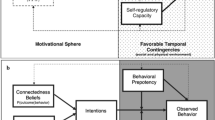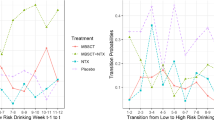Abstract
With technological advances, collection of intensive longitudinal data (ILD), such as ecological momentary assessments, becomes more widespread in prevention science. In ILD studies, researchers are often interested in the effects of time-varying covariates (TVCs) on a time-varying outcome to discover correlates and triggers of target behaviors (e.g., how momentary changes in affect relate to momentary smoking urges). Traditional analytical methods, however, impose important constraints, assuming a constant effect of the TVC on the outcome. In the current paper, we describe a time-varying effect model (TVEM) and its applications to data collected as part of a smoking-cessation study. Differentiating between groups of short-term successful quitters (N = 207) and relapsers (N = 40), we examine the effects of momentary negative affect and abstinence self-efficacy on the intensity of smoking urges in each subgroup in the 2 weeks following a quit attempt. Successful quitters demonstrated a rapid reduction in smoking urges over time, a gradual decoupling of the association between negative affect and smoking urges, and a consistently strong negative effect of self-efficacy on smoking urges. In comparison, relapsers exhibited a high level of smoking urges throughout the post-quit period, a time-varying and, generally, weak effect of self-efficacy on smoking urges, and a gradual reduction in the strength of the association between negative affect and smoking urges. Implications of these findings are discussed. The TVEM is made available to applied prevention researchers through a SAS macro.




Similar content being viewed by others
Notes
It is possible to include a binary indicator of relapse status in a single model for smoking urges. In the current study, however, our goal was to describe the entire system of time-varying relations within each group. By fitting separate models, we essentially allowed relapse state to moderate every aspect of the TVEM.
The time-varying effect of gender was tested for both groups. For relapsers, the overall effect was zero. For successful quitters, a model with three knots fit best, although the overall effect was very small. Specifically, the non-zero relation between gender and intensity of smoking urges did not emerge until day 10, with women reporting urges about .2 points higher than men.
References
Akaike, H. (1974). A new look at the statistical model identification. IEEE Transactions on Automatic Control, 19, 716–723.
Baer, J. S., Holt, C. S., & Uchtenstein, E. (1986). Self-efficacy and smoking reexamined: Construct validity and clinical utility. Journal of Consulting and Clinical Psychology, 54, 846–852.
Baker, T. B., Morse, E., & Sherman, J. E. (1987). The motivation to use drugs: A psychobiological analysis of urges. In P. C. Rivers (Ed.), The Nebraska symposium on motivation: Alcohol use and abuse (pp. 257–232). Lincoln: University of Nebraska Press.
Baker, T. B., Piper, M. E., McCarthy, D. E., Majeskie, M. R., & Fiore, M. C. (2004). Addiction motivation reformulated: An affective processing model of negative reinforcement. Psychological Review, 111, 33–51.
Berkman, E. T., Dickenson, J., Falk, E. B., & Lieberman, M. D. (2011). Using SMS text messaging to assess moderators of smoking reduction: Validating a new tool for ecological measurement of health behaviors. Health Psychology, 30, 186–194.
Bolger, N., Davis, A., & Rafaeli, E. (2003). Diary methods: Capturing life as it is lived. Annual Review of Psychology, 54, 579–616.
Brandon, T. H. (1994). Negative affect as motivation to smoke. Current Directions in Psychological Science, 3, 33–37.
Cinciripini, P. M., Wetter, D. W., & McClure, J. B. (1997). Scheduled reduced smoking: Effects on smoking abstinence and potential mechanisms of action. Addictive Behaviors, 22, 759–767.
Ebner-Priemer, U. W., Kubiak, T., & Pawlik, K. (2009). Ambulatory assessment. European Psychologist, 14, 95–97.
Fahrenberg, J., Myrtek, M., Pawlik, K., & Perrez, M. (2007). Ambulatory assessment - Monitoring behavior in daily life settings: A behavioral-scientific challenge for psychology. European Journal of Psychological Assessment, 23, 206–213.
Garcia, M. E., Schmitz, J. M., & Doerfler, L. A. (1990). A fine-grained analysis of the role of self-efficacy in self-initiated attempts to quit smoking. Journal of Consulting and Clinical Psychology, 58, 317–322.
Gulliver, S. B., Hughes, J. R., Solomon, L. J., & Dey, A. N. (1995). Self-efficacy and relapse to smoking in self-quitters. Addiction, 90, 767–772.
Gwaltney, C. J., Metrik, J., Kahler, C. W., & Shiffman, S. (2009). Self-efficacy and smoking cessation: A meta-analysis. Psychology of Addictive Behaviors, 23, 56–66.
Gwaltney, C. J., Shiffman, S., Balabanis, M. H., & Paty, J. A. (2005). Dynamic self-efficacy and outcome expectancies: Prediction of smoking lapse and relapse. Journal of Abnormal Psychology, 114, 661–675.
Hastie, T., & Tibshirani, R. (1993). Varying-coefficient models. Journal of the Royal Statistical Society. Series B (Methodological), 55, 757–779.
Hoover, D. R., Rice, J. A., Wu, C. O., & Yang, L. P. (1998). Nonparametric smoothing estimates of time-varying coefficient models with longitudinal data. Biometrika, 85, 809–822.
Kassel, J. D., Stroud, L. R., & Paronis, C. A. (2003). Smoking, stress, and negative affect: correlation, causation, and context across stages of smoking. Psychological Bulletin, 129, 270–304.
Killen, J. D., Fortmann, S. P., Newman, B., & Varady, A. (1991). Prospective study of factors influencing the development of craving associated with smoking cessation. Psychopharmacology, 105, 191–196.
Larson, R., & Csikszentmihalyi, M. (1983). The experience sampling method. New Directions for Methodology of Social and Behavioral Science, 15, 41–56.
Li, R., Root, T. L., & Shiffman, S. (2006). A local linear estimation procedure of functional multilevel modeling. In T. Walls & J. L. Schafer (Eds.), Models for intensive longitudinal data (pp. 63–83). New York: Oxford University Press.
Marlatt, G. A., & Gordon, J. R. (1985). Relapse prevention: Maintenance strategies in the treatment of addictive behaviors. New York: Guilford Press.
McCarthy, D. E., Piasecki, T. M., Fiore, M. C., & Baker, T. B. (2006). Life before and after quitting smoking: an electronic diary study. Journal of Abnormal Psychology, 115, 454–466.
Niaura, R., Shadel, W. G., Britt, D. M., & Abrams, D. B. (2002). Response to social stress, urge to smoke, and smoking cessation. Addictive Behaviors, 27, 241–250.
Piasecki, T. M. (2006). Relapse to smoking. Clinical Psychology Review, 26, 196–215.
Piasecki, T. M., Fiore, M. C., McCarthy, D. E., & Baker, T. B. (2002). Have we lost our way? The need for dynamic formulations of smoking relapse proneness. Addiction, 97, 1093–1108.
Piasecki, T. M., Kenford, S. L., Smith, S. S., Fiore, M. C., & Baker, T. B. (1997). Listening to nicotine: Negative affect and the smoking withdrawal conundrum. Psychological Science, 8, 184.
Raudenbush, S. W., & Bryk, A. S. (2002). Hierarchical linear models: Applications and data analysis methods (2nd ed.). Thousand Oaks, CA: Sage.
Rodgers, A., Corbett, T., Bramley, D., Riddell, T., Wills, M., Lin, R. B., et al. (2005). Do u smoke after txt? Results of a randomised trial of smoking cessation using mobile phone text messaging. Tobacco Control, 14, 255–261.
Schwarz, G. E. (1978). Estimating the dimension of a model. Annals of Statistics, 6, 461–464.
Schwartz, J. E., & Stone, A. A. (1998). Strategies for analyzing ecological momentary assessment data. Health Psychology, 17, 6–16.
Schwartz, J. E., & Stone, A. A. (2007). The analysis of real-time momentary data: A practical guide. In A. A. Stone, S. Shiffman, A. A. Atienza, & L. Nebeling (Eds.), The science of real-time data capture: Self-reports in health research (pp. 76–113). New York: Oxford University Press.
Shadel, W. G., & Mermelstein, R. J. (1993). Cigarette smoking under stress: The role of coping expectancies among smokers in a clinic-based smoking cessation program. Health Psychology, 12, 443–450.
Shiffman, S. (2005). Dynamic influences on smoking relapse process. Journal of Personality, 73, 1715–1748.
Shiffman, S. (2009). Ecological momentary assessment (EMA) in studies of substance use. Psychological Assessment, 21, 486–497.
Shiffman, S., Balabanis, M. H., Paty, J. A., Engberg, J., Gwaltney, C. J., Liu, K. S., et al. (2000). Dynamic effects of self-efficacy on smoking lapse and relapse. Health Psychology, 19, 315–323.
Shiffman, S., Engberg, J. B., Paty, J. A., Perz, W. G., Gnys, M., Kassel, J. D., et al. (1997). A day at a time: Predicting smoking lapse from daily urge. Journal of Abnormal Psychology, 106, 104–116.
Shiffman, S., Gnys, M., Richards, T., Paty, J. A., Hickcox, M., & Kassel, J. D. (1996). Temptations to smoke after quitting: A comparison of lapsers and maintainers. Health Psychology, 15, 455–461.
Shiffman, S., Gwaltney, C. J., Balabanis, M. H., Liu, K. S., Paty, J. A., Kassel, J. D., et al. (2002). Immediate antecedents of cigarette smoking: An analysis from ecological momentary assessment. Journal of Abnormal Psychology, 111, 531–545.
Shiffman, S., Hickcox, M., Paty, J. A., Gnys, M., Kassel, J. D., & Richards, T. J. (1996). Progression from a smoking lapse to relapse: Prediction from abstinence violation effects, nicotine dependence, and lapse characteristics. Health Psychology, 64, 993–1002.
Shiffman, S., & Jarvik, M. (1976). Smoking withdrawal symptoms in two weeks of abstinence. Psychopharmacology, 50, 35–39.
Shiffman, S., Paty, J. A., Gnys, M., Kassel, J. A., & Hickcox, M. (1996). First lapses to smoking: Within-subjects analysis of real-time reports. Journal of Consulting & Clinical Psychology, 64, 366–379.
Shiffman, S., Stone, A. A., & Hufford, M. R. (2008). Ecological momentary assessment. Annual Review of Clinical Psychology, 4, 1–32.
Shiffman, S., & Waters, A. J. (2004). Negative affect and smoking lapses: A prospective analysis. Journal of Consulting and Clinical Psychology, 72, 192–201.
Singer, J. D., & Willett, J. B. (2003). Applied longitudinal data analysis: Modeling change and event occurrence. New York: Oxford University Press.
Smyth, J. M., & Stone, A. A. (2003). Ecological momentary assessment research in behavioral medicine. Journal of Happiness Studies, 4, 35–52.
Stone, A. A., & Shiffman, S. (1994). Ecological momentary assessment (EMA) in behavioral medicine. Annals of Behavioral Medicine, 16, 199–202.
Tan, X., Shiyko, M. P., Li, R., Li, Y., & Dierker, L. (2010). Intensive longitudinal data and model with varying effects (Technical Report No. 10–106). University Park, PA: The Methodology Center, The Pennsylvania State University.
Trull, T. J., & Ebner-Priemer, U. W. (2009). Using experience sampling methods/ecological momentary assessment (ESM/EMA) in clinical assessment and clinical research: Introduction to the special section. Psychological Assessment, 21, 457–462.
Van Zundert, R. M. P., Boogerd, E. A., Vermulst, A. A., & Engels, R. C. M. E. (2009). Nicotine withdrawal symptoms following a quit attempt: An ecological momentary assessment study among adolescents. Nicotine & Tobacco Research, 11, 722–729.
Walls, T. A., & Schafer, J. L. (Eds.) (2006). Modeling for intensive longitudinal data. New York, NY: Oxford University Press.
Wetter, D. W., Smith, S. S., Kenford, S. L., Jorenby, D. E., Fiore, M. C., Hurt, R. D., et al. (1994). Smoking outcome expectancies: Factor structure, predictive validity, and discriminant validity. Journal of Abnormal Psychology, 103, 801–811.
Author Note
The authors would like to thank Linda Collins, John Dziak, Charu Mathur, C.J. Powers, and Violet (Shu) Xu for comments on earlier drafts of this manuscript, and Amanda Applegate for her editorial suggestions. The work of Shiyko, Lanza, Tan, & Li was supported by the National Institute on Drug Abuse grant P50 DA010075-14 and R21 DA024260. The work of Shiffman was supported by the National Institute on Drug Abuse grant DA06084. The content of this manuscript is solely the responsibility of the authors and does not necessarily represent the official views of the National Institute on Drug Abuse or the National Institutes of Health.
Author information
Authors and Affiliations
Corresponding author
Appendices
Appendix 1
Appendix 2
Rights and permissions
About this article
Cite this article
Shiyko, M.P., Lanza, S.T., Tan, X. et al. Using the Time-Varying Effect Model (TVEM) to Examine Dynamic Associations between Negative Affect and Self Confidence on Smoking Urges: Differences between Successful Quitters and Relapsers. Prev Sci 13, 288–299 (2012). https://doi.org/10.1007/s11121-011-0264-z
Published:
Issue Date:
DOI: https://doi.org/10.1007/s11121-011-0264-z




